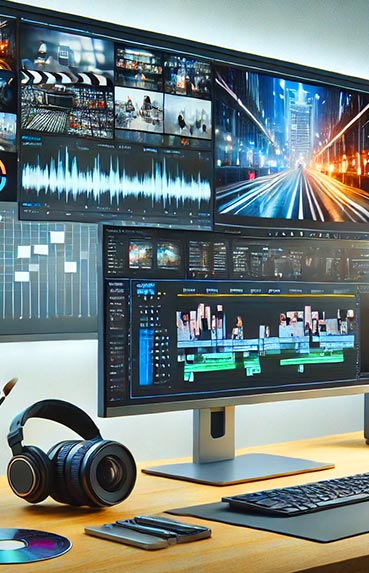In today's digital world, animated explainer videos have become an essential tool for the effective communication of ideas and concepts. These videos not only capture the audience's attention but also facilitate the understanding of complex topics in a visually appealing way. If you're considering creating an animated explainer video, this article will provide you with a comprehensive guide on the best techniques to achieve it.
Understanding the Importance of Animated Explainer Videos
Why Are They Effective?
Animated explainer videos are effective because they combine visual, narrative, and auditory elements to convey information clearly and concisely. Studies have shown that people retain 95% of information when they watch it in a video, compared to just 10% when reading it in text. This retention capability is due to the fact that videos engage multiple senses, making learning and memorization easier.
Benefits for Businesses and Educators
For businesses, animated explainer videos can be a powerful tool to increase conversion rates. According to a Wyzowl survey, 81% of companies using explainer videos saw an increase in sales. In the educational field, these videos can make complex topics more accessible to students, enhancing their understanding and engagement.
Planning the Explainer Video
Defining Clear Objectives
Before starting the production of an explainer video, it's crucial to define the objectives you wish to achieve. Ask yourself: What message do I want to convey? and Who is my audience? Having clarity in these aspects will help you create a script and visual design that resonates with your audience.
Research and Information Gathering
Once you've defined your objectives, the next step is to research and gather the necessary information for your video. It's important to ensure that the content is accurate, relevant, and up-to-date. Use reliable sources and, if possible, include data and statistics to support your message.
Script Creation
Script Structure
The script is the backbone of your explainer video. It should be well-structured to guide the viewer through the information in a logical and smooth manner. A typical structure might include:
- Introduction: Present the problem or topic in an intriguing way.
- Body: Explain the solution or concept in detail.
- Conclusion: Summarize the key points and make a call to action.
Writing Clearly and Concisely
When drafting the script, use simple and direct language. Avoid technical jargon unless absolutely necessary, and ensure that each sentence contributes to the video's objective. Remember that clarity is key to understanding.
Visual Design and Animation
Selecting a Visual Style
The visual style of your video should be consistent with your brand identity and appealing to your audience. Some popular styles include:
- 2D Animation: Versatile and cost-effective, ideal for most explainer videos.
- Whiteboard Animation: Effective for illustrating step-by-step concepts.
- Motion Graphics: Perfect for conveying complex information dynamically.
Creating a Storyboard
A storyboard is an essential tool for planning the visual design of your video. It consists of a series of illustrations representing each scene of the script. This will help you visualize how the narrative will unfold and make adjustments before starting the animation.
A well-crafted storyboard can save time and effort during production, as it provides a clear guide for the animation team.
Animation and Editing
During the animation phase, it's important to maintain a suitable pace to keep the viewer's interest. Smooth transitions and well-used visual effects can enhance the user experience. In editing, ensure that the audio and graphics are synchronized and that the video flows seamlessly.
Audio Integration
Choosing Background Music
Background music can set the tone of the video and affect the perception of the message. Choose music that complements the content without distracting the viewer. It's crucial that the music volume does not interfere with the narration.
Professional Voice Over
A clear and professional voice-over can make a significant difference in the quality of your video. Consider hiring an experienced voice actor who can convey the appropriate tone and make the content accessible and engaging.
Practical Tips for Success
Adapting to the Audience
It's vital to adapt the content and style of the video to your audience's preferences. Conduct A/B tests to evaluate which versions of the video resonate best with different segments of your target audience.
Optimization for Platforms
Each platform has its own specifications and format requirements. Ensure that you optimize your video for the platform where it will be published, whether it's YouTube, Instagram, LinkedIn, among others. Consider the video's length, file size, and dimensions.
Measuring Performance
Once the video is published, use analytical tools to measure its performance. Analyze metrics such as retention rate, interactions, and conversions to evaluate the video's success and make future adjustments.
Innovations and Trends in Explainer Videos
Augmented and Virtual Reality
Augmented reality (AR) and virtual reality (VR) technologies are beginning to integrate into explainer videos, offering immersive experiences that can increase viewer engagement. These technologies allow users to interact with content in a unique way, providing a deeper understanding.
Content Personalization
Personalization is becoming a key trend in creating explainer videos. Using user data to personalize content can significantly increase the video's relevance and impact. This can be achieved through the use of automation software and data analysis.
Artificial Intelligence in Video Production
Artificial intelligence (AI) is transforming the way explainer videos are produced. AI-based tools can assist in script creation, image selection, and video editing, streamlining the production process and allowing for a more creativity-focused approach.
Useful Tools and Resources
Animation Software
There are several software tools that facilitate the creation of animated explainer videos. Some of the most popular include:
- Adobe After Effects: Ideal for complex animations and motion graphics.
- Toon Boom Harmony: Perfect for high-quality 2D animation.
- Vyond: Easy-to-use online tool for quickly creating explainer videos.
Audio and Music Resources
Some platforms offer royalty-free music and sound effects that can be used in explainer videos:
- Epidemic Sound: Extensive library of music and sound effects.
- AudioJungle: Royalty-free music marketplace with varied options.
- Freesound: Online community sharing free sound effects.
Analytics Platforms
To measure the performance of your videos, consider using analytics platforms like:
- Google Analytics: Offers detailed insights into user behavior.
- YouTube Analytics: Provides specific data on video performance on YouTube.
- Vimeo Analytics: Allows analysis of audience interaction with videos published on Vimeo.
With these techniques and tools at your disposal, you are ready to create animated explainer videos that not only inform but also captivate your audience. Remember that the key lies in meticulous planning, careful execution, and constant analysis for continuous improvement.

















